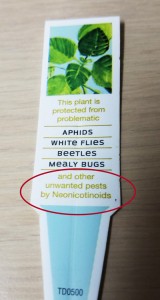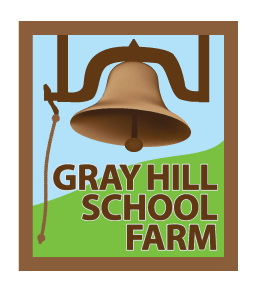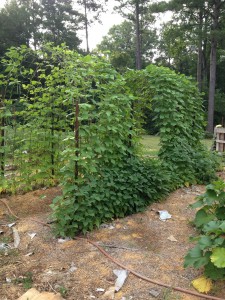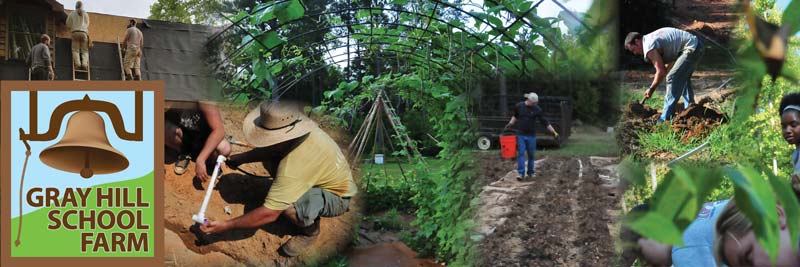What are Neonicotinoids? Why should we all be concerned, upset, outraged? If you don’t read any further, read this: Neonicotinoids are a LEGAL (now in 2016) insecticide that has been linked to honeybee colony collapse.
First of all, this topic is not new, this group of chemicals is not new and the information and concerns about the findings are not new. Government action on this topic is moving at glacier speed. Moving, yes…quickly, no. You should be aware of this information and keep yourself knowledgeable. It effects YOU.
Neonicotinoids are a specialized systemic agricultural insecticide resembling nicotine. Systemic means that it is actually in the plant. Many are water soluble so they can be taken up by the plant as it grows. The first commercial use was as a seed coating. You probably remember seeing corn seed coated with a pink powder. There are several “varieties” of neonicotinoids including Nitenpyram, Dinotefuran, Thiacloprid, Acetamiprid, Clothianidin, Thiamethoxam and Imidacloprid. Invented back near the 1970’s and coming under scrutiny back in the 1990’s, these chemicals have been used all over the world. Eighty percent of all seeds in 2008 were treated with neonicotinoids.
In 2008, the link to colony collapse became more prominent when a planted cornfield undeniably poisoned a massive amount of nearby honeybees in Germany. Germany suspended use, followed by France and Italy. The U.S. did not. Again, a 2012 study found thiamethozam and clothianidin (both neonicotinoids) in dead bees in agricultural settings. Some bees still alive had tremors and convulsions both indicating poison. Tests also proved that corn pollen foraged by bees tested positive for neonicotinoids. Recent research establishes toxicity for both honeybees and other beneficial insects even with very low levels of contact.
In 2013 almost all corn in the US was treated with either clothianidin or thiamethoxam. And a year later the soybean growers joined in along with cotton and sugar beets. Now, soybean growers are using the most neonicotinoids of any major crop. Yes, increasing use, not decreasing! Bayer Cropscience and Syngenta are two major manufacturers of neonicotinoids whose names you probably recognize. So, the U.S. continues to allow use… why? The U.S. Environmental Protection Agency (EPA) operates a 15-year review cycle for all pesticides… let that sink in… 15 years!
 But there’s more. These chemicals are not limited for use by commercial growers. Many plants and seeds sold to consumers are treated as well as the availability of “consumer use” insecticides for purchase. Locally, (in 2016) we found tags on plants in Home Depot labeling the plant as being treated with neonicotinoids. Specifically, one of the plants was a Butterfly Bush, a pollinator attracting plant! (A Butterfly bush is not usually susceptible to invasive insects anyway.) So, a plant purchased specifically to provide forage for pollinators may actually be doing harm. The tags found were not prominent. Apparently, Home Depot requires plants treated with neonicotinoids be labeled as such, but the company continues to sell them. How many plants are available to buy nationwide that are not labeled? There is no law that consumers must know the plant has been treated with a systemic insecticide. Still, Home Depot is knowingly selling neonicotinoid infused plants.
But there’s more. These chemicals are not limited for use by commercial growers. Many plants and seeds sold to consumers are treated as well as the availability of “consumer use” insecticides for purchase. Locally, (in 2016) we found tags on plants in Home Depot labeling the plant as being treated with neonicotinoids. Specifically, one of the plants was a Butterfly Bush, a pollinator attracting plant! (A Butterfly bush is not usually susceptible to invasive insects anyway.) So, a plant purchased specifically to provide forage for pollinators may actually be doing harm. The tags found were not prominent. Apparently, Home Depot requires plants treated with neonicotinoids be labeled as such, but the company continues to sell them. How many plants are available to buy nationwide that are not labeled? There is no law that consumers must know the plant has been treated with a systemic insecticide. Still, Home Depot is knowingly selling neonicotinoid infused plants.
Although small, Maryland, on a state level, in April of 2016, has restricted the use of insecticides “by consumers” containing neonicotinoids. A partial ban is better than no ban. Maryland has at least recognized the problem.
The EPA is evaluating this insecticide group and is said to release its findings in 2018… like I said, glacier speed.
Please research this topic on your own, read labels, check tags and hopefully choose NOT to buy neonicotinoid products, plants and seeds.

 After much study and prayer toward serving my community, Gray Hill School Farm was created on faith. A not for profit entity, our mission is to be a catalyst for sustainable community abundance through research and education.
After much study and prayer toward serving my community, Gray Hill School Farm was created on faith. A not for profit entity, our mission is to be a catalyst for sustainable community abundance through research and education. Making use of hearty, fast-growing plants for shade can be beneficial to the plant as well as offering shade for the gardener. The sun in the middle of the day is the hottest and growing plants on straight steaks won’t help with temperature. Consider growing in an arch where you, the gardener, can get some overhead coverage from the sun. This also shades the plant’s root area and helps with water retention in the soil.
Making use of hearty, fast-growing plants for shade can be beneficial to the plant as well as offering shade for the gardener. The sun in the middle of the day is the hottest and growing plants on straight steaks won’t help with temperature. Consider growing in an arch where you, the gardener, can get some overhead coverage from the sun. This also shades the plant’s root area and helps with water retention in the soil. Worms are so important to the health of your garden. It’s recently been discovered that a worm simply rubbing up against a plant’s roots can inoculate that plant against most soil-born diseases.
Worms are so important to the health of your garden. It’s recently been discovered that a worm simply rubbing up against a plant’s roots can inoculate that plant against most soil-born diseases.